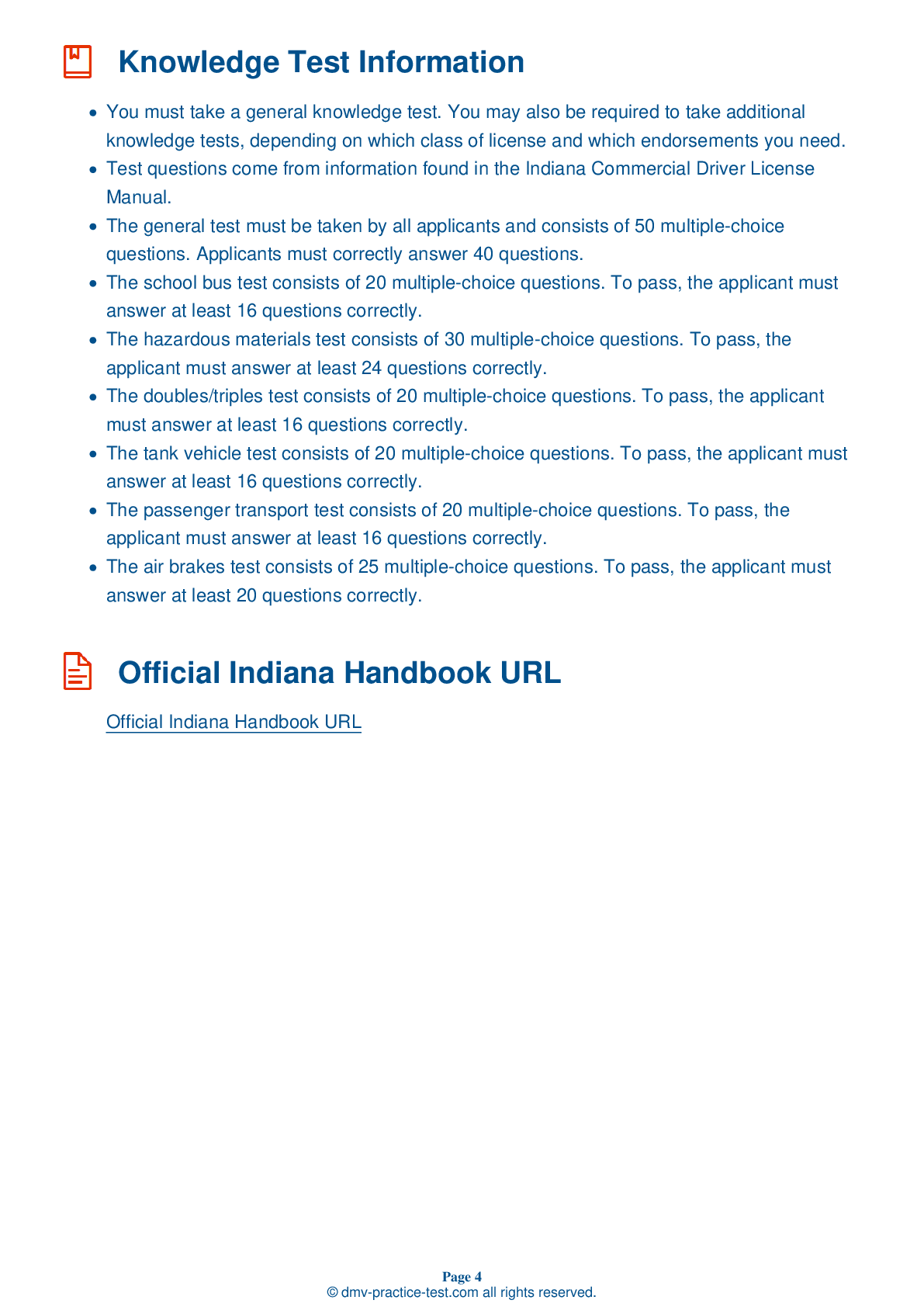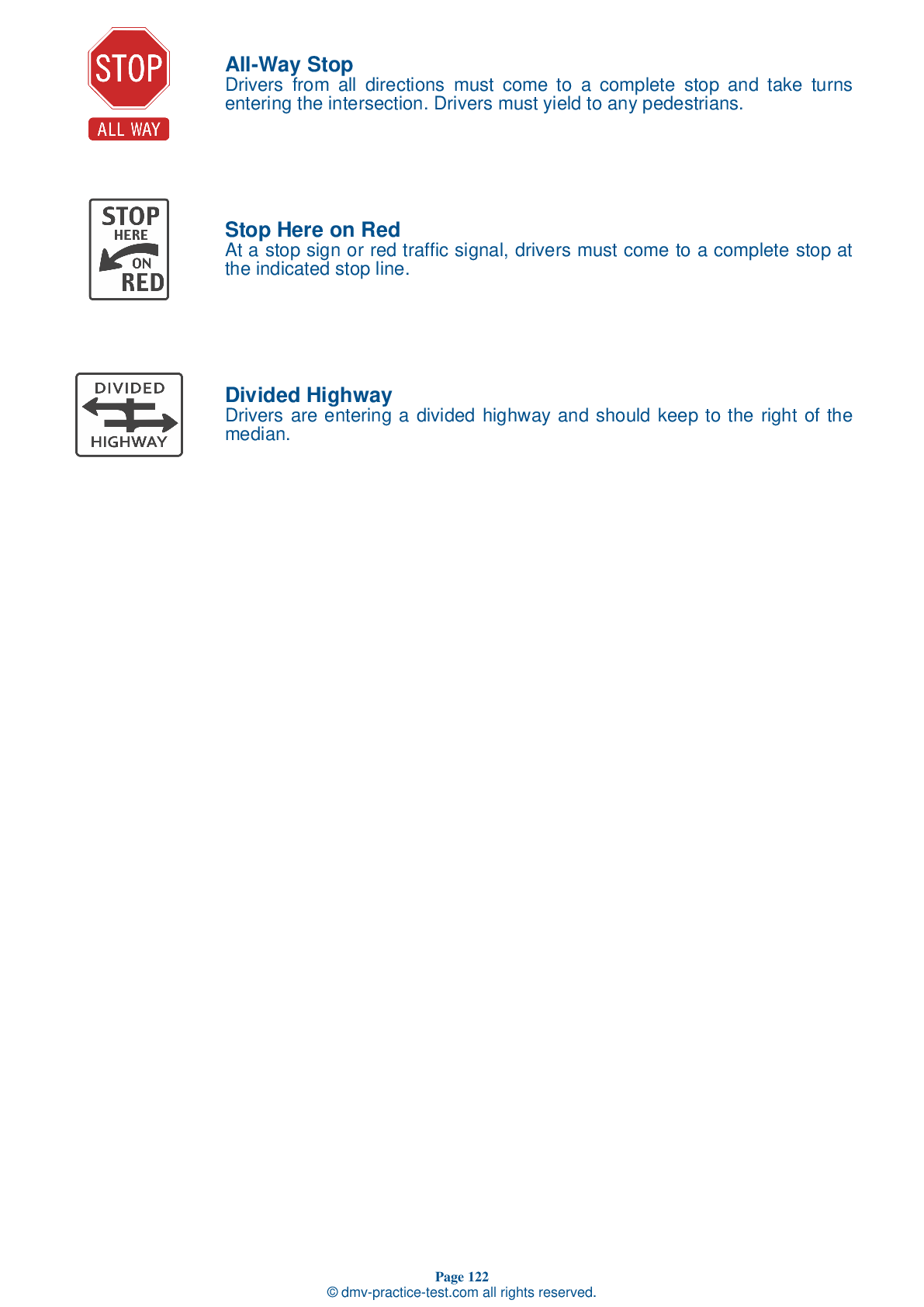Air Brakes #1
Air Brakes Endorsement Test | Indiana 2025 #1 Page 4 of 4
Train for FREE online with our Indiana CDL air brake test. The official exam test consists of several obligatory parts, with all of them checking your knowledge of different blocks of road rules. If you need to obtain a IN Class A/Class B driver license in 2025, practice as much as possible. Free sample tests published on our website will help you check and improve your knowledge and boost your grades. Please bear in mind that the requirements for CDL may vary from state to state.
25
20
20
19 . Most heavy-duty vehicles use:
Quadruple air brake systems.
Most heavy-duty vehicles use dual air brake systems, in which there are two separate braking systems operated by a single set of controls. Each system operates the brakes on different axles.
20 . If one air system in a dual air brake system is very low on pressure:
Lights on the outside of the tractor will flash.
In a dual air brake system, if one of the air systems gets very low on pressure, either the front or rear brakes will not be operating fully. You should bring your vehicle to a safe stop and have the air system repaired.
21 . If braking at a speed of 55 mph while driving on dry pavement, the brake lag can add ____ to your vehicle's total stopping distance.
10 feet
The total stopping distance for vehicles equipped with air brakes is made up of four factors: perception distance, reaction distance, brake lag distance, and braking distance. When braking at a speed of 55 mph while driving on dry pavement, the brake lag can add around 32 feet to a vehicle's total stopping distance.
22 . Foundation brakes are used:
At each wheel.
Foundation brakes are used at each wheel. The most common type is the S-cam drum brake.
23 . Failing to drain the tanks in an air brake system can result in:
Too much fuel being carried.
In an air brake system, the air storage tanks must be drained to remove accumulated water and compressor oil. Failing to do this can cause damage. For example, water that has built up in the system could freeze in cold weather and cause brake failure.
24 . A low air pressure warning signal should activate:
When tank pressure falls below 5 psi.
In an air brake system, a low air pressure warning signal must come on if air pressure in the tanks falls below 55 psi. This warning signal may come in the form of a light, a buzzer, or a wig wag.
25 . Air brakes are:
A tool to improve fuel efficiency.
As long as the brakes are properly maintained, using air brakes is a safe and effective method of stopping large, heavy vehicles.
2025 Indiana | Frequently Asked Questions
To acquire a CDL Hazmat endorsement in Indiana, you must hold a valid CDL. Then, pass the Hazardous Materials Endorsement Knowledge Test at a BMV branch. After passing, submit fingerprints for a federal TSA background check. Once cleared, you'll receive your endorsement. Remember, the endorsement must be renewed every five years with a new background check.
To obtain a CDL Hazmat license in Indiana, you must first have a commercial driver's license (CDL). Then, you'll need to pass the Hazardous Materials Endorsement Knowledge Test, provide proof of U.S. citizenship or lawful permanent residency, and pass a TSA background check. Finally, you must submit a self-certification form and medical examiner's certificate.
To apply for a CDL Hazmat endorsement in Indiana, you must provide: proof of U.S. citizenship or lawful permanent residency (e.g., passport, birth certificate), your current CDL, proof of Indiana residency, and a completed application. Additionally, a medical examiner's certificate and a self-certification form are required. Lastly, you'll need documentation confirming you passed the TSA background check.
Yes, there is a dedicated written test for the CDL Hazmat endorsement in Indiana. The Hazardous Materials Endorsement Knowledge Test is designed to evaluate your understanding of the regulations and safety procedures associated with transporting hazardous materials. It's important to prepare thoroughly for this test using the Indiana CDL manual or other study materials.
The written test for the CDL Hazmat endorsement covers several subjects including: understanding hazard classifications, recognizing placards and labels, transporting hazardous materials safely, loading and unloading hazardous materials, and handling emergencies or accidents involving hazardous materials. It also tests knowledge about federal and state regulations for transporting such materials.
Yes, there are extra charges associated with acquiring a CDL Hazmat endorsement in Indiana. These include fees for the knowledge test, endorsement application, and fingerprinting for the TSA background check. The exact fees can vary, so it's recommended to check with the Indiana Bureau of Motor Vehicles or the TSA for current pricing.
Yes, background checks and security clearances are mandatory for the CDL Hazmat endorsement in Indiana. The Transportation Security Administration (TSA) conducts a fingerprint-based Criminal History Records Check and a security threat assessment to ensure the applicant does not pose a security threat. This is a federal requirement for all states.
Yes, specialized training is required for the CDL Hazmat endorsement. You must pass a written test that covers topics like handling hazardous materials, recognizing placards and labels, and emergency procedures. After passing, you'll receive a certificate of training which is mandatory when applying for the endorsement. Regular refresher training is also required.
No, you cannot legally transport hazardous materials without a valid CDL Hazmat endorsement in Indiana. The endorsement ensures that drivers have the necessary training and knowledge to handle and transport hazardous materials safely. Violating this requirement can result in significant fines and penalties.
Yes, you can add the CDL Hazmat endorsement to your current CDL license. It doesn't require a new application for a CDL, but you must pass the Hazmat knowledge test, pay the endorsement fee, and successfully complete the TSA background check and fingerprinting.



